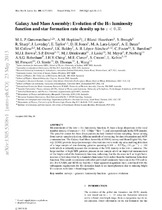Galaxy and mass assembly: evolution of the Hα luminosity function and star formation rate density up to z < 0.35
Date
2013Author
Gunawardhana, M.L.P.
Hopkins, A.M.
Bland–Hawthorn, J.
Prescott, M.
Metadata
Show full item recordAbstract
Measurements of the low-z Hα luminosity function, Φ, have a large dispersion in the local number density of sources (∼0.5–1 Mpc−3 dex−1), and correspondingly in the star formation rate density (SFRD). The possible causes for these discrepancies include limited volume sampling, biases arising from survey sample selection, different methods of correcting for dust obscuration and active galactic nucleus contamination. The Galaxy And Mass Assembly (GAMA) survey and Sloan Digital Sky Survey (SDSS) provide deep spectroscopic observations over a wide sky area enabling detection of a large sample of star-forming galaxies spanning 0.001 < SFRHα (M⊙ yr− 1) < 100 with which to robustly measure the evolution of the SFRD in the low-z Universe. The large number of high-SFR galaxies present in our sample allow an improved measurement of the bright end of the luminosity function, indicating that the decrease in Φ at bright luminosities is best described by a Saunders functional form rather than the traditional Schechter function. This result is consistent with other published luminosity functions in the far-infrared and radio. For GAMA and SDSS, we find the r-band apparent magnitude limit, combined with the subsequent requirement for Hα detection leads to an incompleteness due to missing bright Hα sources with faint r-band magnitudes.

